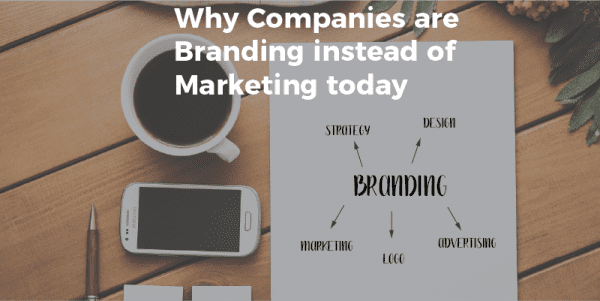Why Companies are Branding instead of Marketing today

 Did that capture your attention? Great.
Did that capture your attention? Great.
One of the most common misconceptions people have about branding and marketing is that they are one and the same. They are actually two sides of a coin which complement each other. Branding is holistic and governs who you are while marketing is used to expand your brand outreach and achieve specific outcomes.
Today, branding is more important than ever as consumers are increasingly discerning. Emotional influences affect decision-making and understanding this trait of consumer behaviour is essential in order to develop a real connection with the target audience. Businesses need to show that they are more than profit organisations, that they are humane, and this can be communicated through branding. And this is the channel that will help evoke the right emotions to convince that you are better than your competitors in an ever-crowded, homogeneous marketplace.
Customers want you to understand them.
Customers today are smarter than they were decades ago, primarily because information is easier to find now with the internet. As such, customers have higher expectations causing marketing to take on a more holistic role. Today, customer sentiments revolve around purchasing from companies that are transparent and caring. Companies are just expected to know more about their loyal consumers.
The best way to solve that? Branding.
When consumers can relate themselves to your products and services, that’s where you hit the sweet spot in connecting with them on an emotional level. And we all know that purchases are made based on emotions.
How Marketing and Branding work together

It is vital to think through how you want your audience to see your brand. Spend some time researching and being clear on how you want to build your brand. In a nutshell, deliver on what your brand promises.
When developing your marketing plan, your brand is an overarching guide to your marketing objectives. This ensures that your marketing efforts are in unison with your brand. Customers will know when these two do not align. Also, as branding is about developing that connection, or relationship, with your customers, all efforts are intended to create brand loyalty. And in the world today where consumers are discerning and scarce, achieving brand recall and loyalty is half the battle won.
Branding for Loyalty
You create brand loyalty when customers are happy with 3 key aspects: the product or service performed as intended; quality was as expected or better; the overall experience with your brand was excellent.
Once brand loyalty has been established, you can be more confident of the retention of your customers.
And remember, loyal customers, are also advocates for your brand – which brings us to another loyal advocate, your employees.
Employee Advocates – The Blood of the Company
Having a successful branding creates loyal employees as well, further highlighting the significance of branding. Aside from feeling like a cog in a machine, branding gives your employees a purpose in their jobs. This purpose drives them towards productivity – they now understand that they are part of a more significant cause, not merely just a job anymore. All this creates a sense of belonging to your company too. Remember, this is only possible when you start believing in the benefits of branding.
Unsure of how to start branding?
Here is a good starting point.
As we’ve said earlier, it is wise to spend time thinking about how you want to brand your company. We have two areas where you can start and work from there.
-
What do you believe in your brand?
Aside from giving your employees purpose in their work, you as the owner must have believed in something that made you start this company. What sparked the creation of your company?
Most brands lose sight of the initial goal as they become more established. Ironically, it becomes increasingly important to remember your brand’s goal as you scale and grow.
Understanding what you initially set out to accomplish will help you access which areas of the business have deviated. Unless they are working for you – keep them in check.
Here is what you do.
Get comfortable and think back to the early days of your brand. Jot or write down a few key sentences describing what you initially hoped to achieve. The more detailed, the better.
-
Who are your customers?
Another back-to-basics exercise is knowing WHO your customers really are. You might have been targeting the wrong group – experiencing stagnant or declining sales, or realise that you actually have a unique audience that you can start channelling your marketing strategies towards.
Here is what you do.
If you have a database, it is time to start looking at it with a fine-tooth comb. Group your data by common attributes, such as Gender, or Age, and your data will start making sense.
Alternatively, if you do not have an existing data list (start collating one now), look at your purchases. Are there some products or services that are consistently being purchased? Also, do customers frequently ask questions related to your products/services? These questions guide you in understanding more about your customers and serve as areas to improve on.
In a previous post, The Future of Branding, we threw some suggestions on finding your target audiences.
